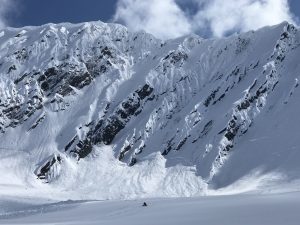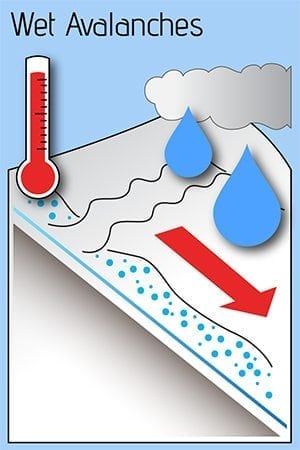Valdez
Above 3,000ftConsiderable
1,500 to 3,000ftModerate
Below 1,500ftModerate
Degrees of Avalanche Danger
Avalanche Problems
Problem 1
Triggering a persistent slab avalanche up to one foot in depth remains a possibility today. 4-12 inches of snow fell on 4/22 above 3500′ depending upon location. Below 3500′ temperatures were warmer preventing much in the way of accumulation.
The 4/22 storm was deposited on near surface facets in shaded protected areas at mid-upper elevation and surface hoar up to 1 cm on upper elevation north facing terrain. On other aspects new snow was deposited on a melt freeze crust. Expect for the 4/22 buried surface hoar layer to remain reactive on high elevation north facing terrain. As additional snowfall is expected today through this weekend, this problem is expected to remain a concern throughout the week as the weight of new snow adds stress to a faceted weak layer in our upper snowpack. Digging snow pits to test the 4/22 interface as well as watching for signs of instability such as shooting cracks and collapsing are good ways to assess this avalanche problem.
In addition to buried surface hoar concerns, north winds developed on 4/23 that redistributed the new snow into sensitive wind slabs. These slabs were found to still have energy on 4/24 especially were they have were deposited on faceted snow. Avoid wind loaded slopes in steep upper elevations, as well as cross loaded terrain at mid-upper elevations.
Likelihood:
- Almost Certain
- Very Likely
- Likely
- Possible
- Unlikely
Size:
- Historic
- Very Large
- Large
- Small
Trend
- Increasing
- Steady
- Decreasing
Problem 2
The degree of wet loose avalanche activity that occurs today will depend on the amount of sun that is able to break through the clouds. If clearing occurs today wet loose avalanches will be likely on solar aspects at all elevations and all aspects at low elevations. Wet loose activity continues to be below average for this time of year. Temperatures are expected to rise during this week along with the potential for rain on snow this weekend. This weather will be increasing the likelihood and size of wet loose activity during the week.
Wet loose avalanches occur when the surface of the snow is heated up, causing the snow to become moist-wet at the surface and lose strength. This process is accentuated on steep rocky slopes that are facing the sun. This type of avalanche problem often starts out with a small point release, which then entrains snow as it moves down hill. The size/ volume of slides that are possible will directly correlate with the size/ relief of the slope, and the steepness and the degree to which the surface has been heated. This avalanche problem can present as very small harmless point releases to very large destructive avalanches that have the potential to step down to deeper layers in the snowpack.
The way to manage this problem is pretty simple. Pay attention to aspect, slopes that are directly facing the sun will be the ones heating up the most. East aspects are the first to heat up during the day followed by south and then west. Realize that even a slight aspect change can make a big difference when it comes to wet loose likelihood during this time of year. Ask yourself, what is the sun doing to the surface snow on the terrain you choose to travel, and on slopes that are above you. Avoid traveling on or being exposed to steep slopes where the sun is making the surface snow wet.
Likelihood:
- Almost Certain
- Very Likely
- Likely
- Possible
- Unlikely
Size:
- Historic
- Very Large
- Large
- Small
Trend
- Increasing
- Steady
- Decreasing
Problem 3
This may be the last problem on the list and least likely to encounter, but it is the most dangerous one. There have been 2 reports in the last 10 days of cornice fall causing very large persistent slabs to full depth avalanches (see avalanche activity section). Avoiding traveling on or exposing yourself to cornices is highly recommended. As the season progresses and temperatures continue to rise, so does the possibility for cornice fall to occur.
Weak snow exists at the base of our snowpack. On 4/15 our area saw the first deep slab activity occur since late February. This occurred on Meteorite (see avalanche activity section) and was a cornice fall that triggered a series of step down avalanches that eventually stepped down to the ground. This is a clear indication that large triggers can have an affect on depth hoar. Increasing temperatures are expected to produce more significant activity later in the season while our snowpack is undergoing a transition from a winter snowpack to a spring one.
This problem is very difficult to assess due its depth and the fact that signs of instability will likely not be present. You can stack the odds in your favor by avoiding steep terrain that is undergoing rapid changes such as strong solar and avoiding exposure to large triggers such as cornices.

Large natural avalanche on Meteorite triggered by cornice fall on 4/15.
Likelihood:
- Almost Certain
- Very Likely
- Likely
- Possible
- Unlikely
Size:
- Historic
- Very Large
- Large
- Small
Trend
- Increasing
- Steady
- Decreasing
Avalanche Activity
Below is a summary of observed Avalanche activity from the last 7 days. Avalanches that were noted earlier in the season can be viewed by clicking the link below.
If you trigger or observe an avalanche consider leaving a public observation.
4/17- Large natural avalanche reported on the upper Tasnuna just east of “The Wall”. Cornice fall was likely the initial trigger with other sympathetic avalanches occurring as well as full depth step downs. SS-Nc-R2.5-D3

– Skier triggered avalanche reported in the Tasnuna valley “The Hammer” SS-ASu-D2-I down 40 cms on 4/7 buried surface hoar/ NE aspect ~5500′. 5th Skier on slope was caught and partially buried in a crevasse/ skier did not sustain any major injuries.
4/15- A cornice fall produced a series of step down avalanches on Meteorite which resulted in failure at the ground. This intiatied as a cornice fall at 6500′ that triggered an avalanche most likely at the 3/9 interface which then stepped down to a persistent slab around 6100′ NE and stepped down to the ground at 5600′ NE.
SS/HS-NC-D3-O/G 6200′ NE, step down to ground ~5600′ NE

Weather
Check out our updated weather tab! A collection of local weather stations are available for viewing with graphs and tabular data included.
NWS Watches, warnings and advisories
NONE
NWS Point forecast for Thompson Pass
Date Wednesday 04/26/23 Thursday 04/27/23 Time (LT) 04 10 16 22 04 10 16 22 04 Cloud Cover OV OV OV OV OV OV OV OV OV Cloud Cover (%) 95 95 90 95 95 80 85 90 90 Temperature 24 30 33 30 27 31 35 33 30 Max/Min Temp 34 27 35 29 Wind Dir N NE SW S E E S S S Wind (mph) 4 3 8 10 10 6 6 9 12 Wind Gust (mph) Precip Prob (%) 20 40 80 70 70 60 70 80 70 Precip Type S S S S S S S S S 12 Hour QPF 0.09 0.17 0.09 0.23 12 Hour Snow 0.4 1.5 0.7 1.8 Snow Level (kft) 0.1 0.5 1.0 0.6 0.5 1.0 1.7 1.5 1.2
Click on link below for Thompson Pass weather history graph:

| Date:
04/26 |
24 hr snow | HN24W* | High temp | Low temp | 72 hour SWE* | April snowfall | Seasonal snowfall | Snowpack Depth |
| Valdez | 0 | 0 | 39 | 31 | 0 | 11 | 248 | 30 |
| Thompson Pass | 0 | 0 | N/O | N/O | N/O | 12 | 438 | N/O |
| 46 mile | 0 | 0 | 45 | 25 | .2 | ~5 | ~117** | 38 |
*HN24W- 24 hour Snow water equivalent in inches
*SWE– Snow water equivalent
**46 mile seasonal snowfall total begins December 1st.
Additional Information
Click on the link below for a running summary of the seasons weather history.
Announcements
The avalanche hazard is Considerable above 3000 feet and moderate below. Multiple avalanche problems exist today, what problems you encounter will be determined by the aspect and elevation that you choose to travel. It remains possible to trigger a wind slab avalanche 6-12 inches in depth on the lee side of upper elevation ridges and cross loaded terrain. Wet loose avalanche activity will also become likely during the heat of the day on solar aspects at all elevations and all aspects at low elevations. Pay attention to the sensitivity of old wind slabs, test the 4/22 interface on upper elevation north facing terrain and avoid traveling on, or being exposed to steep slopes where the sun is creating wet snow at the surface.
Posted by Gareth Brown 04/26 8:00 am.
For a description of current avalanche problems, weather information, season history and more click the (+ full forecast) button. Avalanche forecasts will be issued Wednesday-Sunday through April 30th.
If you have pictures of recent natural or human triggered avalanches or notice signs of instability such as shooting cracks or collapsing, leave an observation to help improve forecast accuracy.


